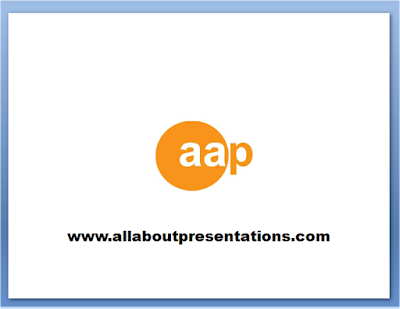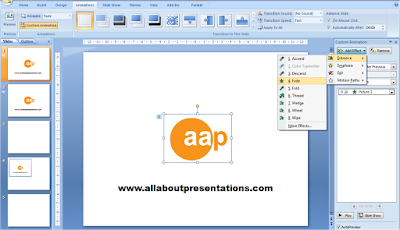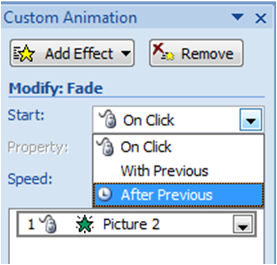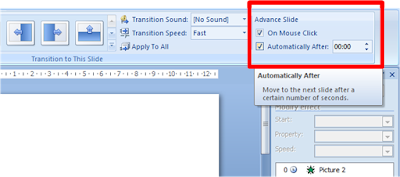I discovered this trick when my superior at work asked me to run a presentation in a loop. The requirement was something like this:
You are organising a conference where you will address a large gathering. Before the actual speech can begin, while the audience is settling down, you need a presentation to run in continuous loop. First the company logo appears, then the tag line, then the screen goes blank, then logo appears again, then the tagline and so on...
A similar example can be found in many multiplexes where they keep running the movie schedule in a continuous loop.
The question in front of me was how to do this. Before you read on to find out how I managed to crack it, think about how you will create this trick in PowerPoint.
The solution: To find out how to do it let us take a case. The logo will be of All About Presentations and there will be the URL coming below it. And this will be in a continuous loop (without any manual intervention).
Step-1: Place the objects on the slide: Place the logo and the URL on the same slide.
 Step-2: Animate the Logo: Click on the AAP logo -> Animations Tab -> Custom Animation -> Add Effect -> Fade (give the desired entrance effect)
Step-2: Animate the Logo: Click on the AAP logo -> Animations Tab -> Custom Animation -> Add Effect -> Fade (give the desired entrance effect)

 Step-3: Automate the animation: By default all the animation happens when you click the mouse. But we need automatic animation. So we choose 'Start: After Previous' in the Custom Animation panel. This means that when the presentation starts, there will be a blank screen and 'after' that this animation will come automatically.You can choose how many seconds after the effect should start. You can also modify the speed of the animation (how fast the logo fades in).
Step-3: Automate the animation: By default all the animation happens when you click the mouse. But we need automatic animation. So we choose 'Start: After Previous' in the Custom Animation panel. This means that when the presentation starts, there will be a blank screen and 'after' that this animation will come automatically.You can choose how many seconds after the effect should start. You can also modify the speed of the animation (how fast the logo fades in).
Step-4: Animate the URL: Click on the text -> Animations Tab -> Custom Animation -> Add Effect -> Color Typewriter (give the desired entrance effect)
Step-5: Automate the animation: Similar to Step-3. If you choose 'Start: After Previous' then this effect comes after the logo has appeared fully. If you choose 'Start: With Previous' then the URL will start appearing along with the logo. Both animations begin together. We will choose After Previous in our case.
If you view the presentation in slide show mode now, then the logo will appear on a blank screen and then the URL will appear and then it will remain that way. There will be no loop. What we need is for the logo and URL to disappear and the animation to start all over again. And this should happen non-stop.
Step-6: Changing the Slide: Go to Animations Tab -> There is an Advance Slide option on the extreme right -> Select 'Automatically After'. You may keep the seconds to 00:00. You may or may not select the 'On Mouse Click' option. This effect makes sure that the slide changes after the URL has been typed (that is, the slide advances after the last animation effect has taken place).

Step-7: Create loop: Go to Tab Slide Show -> Set Up Slide Show -> Under Show Options -> Loop continuously until 'Esc' (this means the presentation will run in a loop until you press the Escape button).
 Run the presentation in slide show mode (shortcut: F5). Your presentation will now run in a loop.
Run the presentation in slide show mode (shortcut: F5). Your presentation will now run in a loop.
If you liked the trick, try it out and have fun!
Dear friend,
There is a small update which I want to share. I would be writing a few articles from now on for the website www.24Point0.com. This is after the website approached me and wanted me to write for them. Every once in a while. Here is the first article I have written on the website.
State of PowerPoint Presentations in India
I have shared some of my thoughts about what ails PowerPoint Presentations in India. I have also shared what I feel are the reasons for the same. To read the article click here. I would love to have your views on the topic.
 I was among those fortunate people who were invited for TED x Hi-Tech City, an independently organised TED event at Indian School of Business, Hyderabad. TED is a great platform for amazing people to come and share their ideas which make a difference to the world around us. TEDx is a program run by TED which allows local, self-organized groups to organize TED-like talks.
I was among those fortunate people who were invited for TED x Hi-Tech City, an independently organised TED event at Indian School of Business, Hyderabad. TED is a great platform for amazing people to come and share their ideas which make a difference to the world around us. TEDx is a program run by TED which allows local, self-organized groups to organize TED-like talks.
The Experience
I went to TEDx with a lot of expectations. After having seen so many TED talks online, I was expecting some good stuff here as well. And I was not at all disappointed. None of the speakers except Nagesh Kukunoor, the famous film director, was a known celebrity. Yet each speaker was doing something in life which was so very different from normal people like us. They all had a great story to tell. How well they told their story, is where their presentation skills come to play.
Lessons I Learnt as a Presenter
I am not going to talk about the life lessons I learnt from each speaker. Let me talk about the lessons I learnt as a presenter. I critically evaluated every speaker on stage and here is what I make out of it.
1. Getting audience attention: Karuna Gopal used a simple trick which I really liked. Suddenly in the middle of the presentation she said, "this is the most important slide of my presentation." This really got my (and everyone's attention) to whatever she showed and said next. You should use this trick once in a while. Use it just once in your presentation though.
2. Simplifying technical presentations: Syed Maqbool, one of the talented men behind the Indian Moon mission, talked about how the Indian scientists actually went to the Moon. His topic was interesting but his presentation became too technical. He also tried to cover more than what the time permitted and hence could not explain all the complex terms and the technology which took the probe to the Moon.
I have a simple suggestion for people who present technical stuff to laymen. "Show your presentation to a group of people who know nothing about the topic, who are like your audience and then take their feedback. Then tweak the presentation to make it easy to understand."
3. Transitions do look good: Deepak Menon from Microsoft showed to the large audience at ISB and to me that transitions can be made to look great. After seeing his presentation, I have had a change of heart (and opinion). I have always recommended people to stay away from transitions. Rather than wasting time thinking about it, use the time to rehearse. But seeing Deepak present, I also felt like playing with transitions in my next presentation.
He used simple transitions after every slide. Once the slide is complete, the entire slide moves up and gives way to the new one. Something like a 'Push Up' transition effect in MS PowerPoint 2007. He used it less and used it very well to add drama to his content. Another speaker Sharath used a simple 'Fade In' and it looked great.
4. Credibility booster: Dr. Neeraj Raj is working towards digitalising content for MBBS courses in India. So that students get access to best in class medical teachers sitting anywhere in India.
While he was making his point, he showed us some news clippings; scanned articles from newspapers. I don't remember what topic it was, but it did help him add credibility to his point. If you are stating some facts which might not be so obvious to your audience, rely on external sources of credibility like newspapers to drive the point home. The audience surely trusts the national newspaper more that it trusts you.
5. Humor works: Everytime a speaker used humor effectively, there were smiles all over. Film director Nagesh Kukunoor used it, Jyotirmaya Sharma used it, Animator Prosenjit Ganguly used it and so did Kanthi. But all these people used humor differently.
While Nagesh talked about some unknown facts about the industry which made people laugh, Kanthi played with words. Jyotirmaya's humor was at times self-deprecatory. Prosenjit created humor by his behaviour and his funny videos. One thing that I learnt from all of this was, humor works. Use it the way you are comfortable. Everyone has a sense of humor. Use humor the way you do it with your friends and colleagues; the natural way.
The next time there is TED or TEDx in your town/city, make sure you visit it. Even if you have to pay for it.
This is a guest post by Edmond Mahony. Edmond is an independent digital strategist and brand planner based in London, UK. One of his current projects is The Ideas Forum – Spotlight Ideas.
Introduction
I worked in a large IT company for many years. My experience of working in that company was that most presentations were left-side-thinking in approach. I imagine most other people in business in general have a similar experience of presentations (?) This article is about presentations that are about being right-side-thinking in approach.
Difference between “normal” presentations and creative presentations What’s the difference between left-side and right-side thinking? Left-side is about linear, logical thinking. Right-side is about creative, lateral-minded thinking. Left-side in presentations, involves, most typically, imparting information with a certain degree of analysis (what many might consider the typical or “normal” presentation). Right-side in presentations, might involve, for example, facts and figures, insights, and analysis, but, most typically, is about getting others to think laterally.
Creative, lateral thinking is crucial in business. Without it you can’t have a business that in some way offers a better product or service than the competition to customers. Without creative, lateral thinking you can’t start a successful business nor can you develop a business and keep it going in a competitive marketplace. Without creative, lateral thinking you can’t have a successful brand, brand story, social media strategy, customer-service approach, and so on.
Creative, lateral thinking involves being creative in:
1 the imaginative sense (most typically in, for example, in advertising, graphic design, industrial design, architecture)
2 the problem solving sense (most typically in, for example, in environmental projects, engineering projects)
3 the entrepreneurial sense (i.e. in setting up an exciting, vibrant business)
4 the leadership sense (i.e. in developing a business, in creating a positive and pro-active work environment)
Creative, lateral-thinking is crucial in business. But how often do we focus on linear, logical-thinking than creative, lateral-minded thinking (?)
The creative presentation is an effective way of injecting creative, lateral-thinking into your business. The “creative presentation” is a broad term. It’s a broad term for many reasons.
1 Business environments differ and require different creative, lateral-minded approaches.
2 A particular business environment might require different creative, lateral-minded approaches. For example, an advertising agency requires a problem-solving approach when coming up with the marketing idea behind a campaign (i.e. is there a particular audience you could focus on and what type of marketing message would work best for this particular group?). And it requires an imaginative approach when coming up with the creative concept (i.e. you have discovered who best to target in your campaign, and what your particular marketing message is – now you have to come up with an idea that captures the imagination of this particular audience i.e. colourful balls bouncing down streets in San Francisco as in the Sony Bravia ad ).
3 Everyone is different. If you copy someone else’s approach, it’s not going to be original. People will see thought it. You must be original. You must surprise your audience. You must do things that makes them sit up. If you don’t get them to sit up, then there is no way you’re going to get them to think creatively. Your focus in to get people to think creatively. Your main focus in the creative presentation is to get people to think creatively
We’re all accustomed to thinking in a linear, logical fashion. Our schools and universities are modelled, largely, on linear, logical thinking. The same with the environment we live in. The same with much of our work in work. The same, probably, with most of the presentations we experience at work. Not easy!
Difference between brainstorming and creative presentations
Brainstorming is getting a select group of people to focus on coming up with as many creative ideas as possible within a certain timeframe. The creative presentation is more relaxed. It’s about getting people to think creatively but not within a certain timeframe. You could get people to give you some feedback at the end of the presentation. But your real goal is to get them to go away and think creatively in their own time and space about some issues or a particular issue . Brainstorming is about quantity of ideas (an idea could be expressed in just one word or a few words). The creative presentation is more about getting people to develop and draw out their own particular ideas (so that they could write pages, if required, on a particular idea). Brainstorming is about intense creative-thinking. The creative presentation is more about getting others to think creatively, in an expansive fashion.
Creative Presentation Rules
Don’t follow rules when preparing for, and giving, creative presentations! Rather, follow general guidelines and then inject the rest with your own, personal, unique approach.
Importance of images in creative presentations
There are various techniques you can use in creative thinking. You can use words, music, props, and so on in a particular, creative ways. This article is only an introduction to creative thinking, and doesn’t go into the details of the various techniques. But if there is one technique to focus on, it is images. The image is a powerful tool in the creative presentation.
- Communication tool. An image is often able to communicate a complicated idea more easily than words can. An image can be used on its own or in combination with words. Scientists often use images to describe complicated ideas in their subjects.
- Emotional response. An image can be effective in drawing out an emotional response in audiences. This is particularly important in creative-thinking where imagination is important (i.e. in advertising, design, architecture, and so on).
- Lateral-thinking. Related to the last point, although different, an image is able to get audiences to think laterally in general.
- Provocative. Related to the last point, again, although a bit stronger in emphasis, images can be provocative in a creative sense. For example, you could use an image in conjunction with a word or phrase where there is some disparity or tension. A sort of tension that leads to productive ideas. Or, for example, instead of word/phrase and an image, use a pair of images where there is, again, some sort of disparity / tension.
Conclusion
The creative presentation is challenging. It’s risky. People might think your presentation is silly or whacky. You might give a good presentations but your audience just happens to be barren of creative ideas for whatever reason.
Social scientists have observed a strong correlation between enjoyment and creativity. So whatever, you do, don’t be boring. If you can’t, initially, engage with people, then you’ll never get to the stage where they will (or want to) think creatively. A good tip here is to adopt an ad lib approach. This doesn’t mean you shouldn’t prepare for your creative presentation. You should prepare for it like any other type of presentation. But you want a certain amount of spontaneous, human engagement.
And, lastly, if using slides, never allow them to become the main focus of attention. You might get away with this, to a degree, with the “normal” presentation. But not with the creative presentation where the slides are props that you refer to, casually – only.
This is a guest post from Joel Xavier, an alumnus of IIM Ahmedabad. He is based out of Pune, India and trains students for various entrance exams including MBA.
This is a slightly long post but is very insightful. It is based on Joel's presentation experience during his recently concluded 5 day training session.
I shot out an SOS email to Vivek one day asking him to provide me with ‘whatever’ content he had on ‘making presentations’ [He is a senior from my MBA days who even back then, was known for his slick presentations]. Why? I was to teach a bunch of engineers-to-be the nuances of making good presentations in about 3 day’s time and I had no clue how I was going to approach it. Who better to ask for guidance than your own senior? I got more than I bargained for.
Within no time I had a long list of twenty odd links pointing back to this blog which was his pick of the best of the basics. I got to work. I was carefully copy pasting the content to a word document for offline reference when it hit me. At the end of almost every article I was reading was an introspective question. Which of these habits are you already following? Which are the ones you would like to try out in your next presentation? Each question was making me think about how exactly I relate to what has just been discussed.
What is my learning out of the whole experience? The whole concept of relating something you have just come to know to some experience you have had in your life, or some particular aspect of the presentation that appealed to you personally was a revelation. It made me sit up and reorganize my entire 5 day training schedule. At the end of each session I would ask the participants in my workshop about what were the one or two specific things that they would remember from the session that just concluded. I was surprised to find that though my topics were very generic, like how to build your CV, and how to participate in discussions, the things the students mentioned as their learning were very personal. Sharing them with the entire group was an amazingly effective way to personalize and retain learning. Participants actually began to look forward to the last 10-15 minutes of each session which were dedicated to this activity.
Among the various articles, there were a few on how to represent data in a presentation. My audience for this workshop comprised third year and final year students of Electrical, IT and Agricultural Engineering. Students who were academically very sound, but had completed most of their education in the regional language. I realized that they would not need much of the charting tips right now, important as they are. And then it dawned on me. I needed to tell them what I was doing myself, understanding the audience. File formats for images and charting tips would come a long way down the line. They would first have to understand their audience.
This entire process was turning into a big learning exercise for me as well. So I decided to reassess the situation. What is my purpose? And as you would have it, I dramatically went into flashback mode. Circa 2005, my first day in Prof. Abhinandan Jain’s class on market research [Jain baba as we referred to him, respectfully]. We had designed a survey and Prof. Jain was making it clear in no uncertain terms that we had failed miserably in our effort. “What is your purpose?” He would bombard us with the same question for every point we made as a class. The words still ring out in my ears. 73 bright managers-to-be racked their brains that day to understand why simplicity and a clear sense of purpose are so absolutely necessary. I now had the opening note to my own presentation. Before you start working on any presentation you need to have a clear objective as to what you aim to achieve through that presentation.
Just remembering about Jain baba brought back another gem of an insight to calm the turbulence that was surrounding my preparations. We used to pride ourselves in making the most dramatic presentations with the best of embellishments, presented with great flourish in those much loved classrooms. Then one day Jain baba punctured our egos in a way which we were to get used to over time.
The presenter was facing a technical problem and the projector decided to play truant. So Jain baba asked him to go ahead and make his point without using the projector. The presenter was petrified and tried to wriggle his way out of the situation claiming he could not do it as there was a lot of important data that the audience had to be shown. What Jain baba said next put the class in a stunned silence. “The power needs to be in your point.”
Over a period of time presentation skills have come to mean Power point skills for a lot of people. I knew I would be laying the right foundations for the participants if I made it clear that MS Power point and projectors are only some of the tools available to you as a presenter. It is necessary to use them as tools and not as crutches.
That said, I had some very strong points to begin with. While preparing a presentation:
- Be clear about your objective
- Understand your audience.
- Focus on the content and not the embellishments.
- Get the audience to relate to the content and make their learning personal
Through my interaction with the audience I realized that the majority of them, like so many of us had come to the workshop thinking of presentations as the thing you do standing in front of a PowerPoint show. I decided to try and break this myth. I had to make it clear that there are innumerable occasions in real life when you are actually required to do a presentation. I gave them the traffic cop presentation.
I asked my audience how many of them had tried making a presentation to a traffic cop to avoid being fined? I got these incredulous looks which made it amply clear that the audience was having a tough time connecting traffic cops and presentations. Then I proceeded to explain how once you are caught violating traffic rules, the entire purpose of your interaction with the cop is to get away with a minimal punishment [your objective]. How the traffic cop actually intends to only censure you and has the power to waive the fine for a warning if he is convinced that you are a responsible driver otherwise [understand your audience]. Convince him about your being a responsible driver by showing him more than just your license willingly. Since two wheelers were relevant to my audience this meant things like the helmet, the pollution control certificate, the tax papers etc. Before I knew it, I was getting that look from my audience. The look that says they have done it, but never thought about it this way. Point well made.
I encouraged my audience to make presentations by using the best tool available to presenters: the mind of the audience. If you can make them visualize the point you want to make, I believe you achieve much more than just getting your point across.
A few other notable tricks from the blog that I used in the training were good humor and chocolates. They are surefire winners if you want to engage your audience much more productively.
About Joel:
Joel ‘Cyclo’ Xavier, an alumnus of IIM Ahmedabad, has worked with Marico and HUL in branding and sales before he got into teaching and training. He is currently based in Pune and trains students for various MBA entrance and other competitive exams. 15 of his students made it to the various IIMs in 2009. He is also a visiting faculty at the University of Pune, department of Management Sciences for marketing. You can find out more about his work on: www.mentorgrid.com
If you also want to share your presentation experience with all of use here, send an email to vivek [at] allaboutpresentations [dot] com.
Yet another month passed by. In January the blog completed one year of existence. 164 posts, 13.7 posts a month and 1 post every 3 days. A huge amount of time and effort has gone in the last one year and will continue to go in every month.
I would like to list down the most read posts of the blog in the last one year. Here is the list:
#1 How to make sponsorship proposal presentations?
#2 How many slides should your presentations have?
#3 How to make a business review presentation?
#4 7 lessons from Dr. Steven Covey's presentation
#5 An introduction to SmartArt graphics
#6 How to create your own template in PowerPoint?
#7 How to add hyperlink to SmartArt?
#8 Checklist for making any presentation
#9 Free E-Book on 14 Tips to make awesome charts
#10 How to present one bullet at a time?
Coming to January 2010, I shared a couple of tricks on PowerPoint and talked about the amazing talk by Devdutt Pattanaik. No wonder the most read posts of the last month are:
#1 How to create a lunar eclipse using PowerPoint?
#2 TED India Talk: Devdutt Pattanaik
#3 Why we should avoid the edges of the slide?
In the coming month, I will be sharing with you some interesting developments that have taken place in January. There is a lot in store. Keep reading and keep writing to me. If you have something to share or discuss email it to vivek [at] allaboutpresentations [dot] com.


 Step-3: Automate the animation: By default all the animation happens when you click the mouse. But we need automatic animation. So we choose 'Start: After Previous' in the Custom Animation panel. This means that when the presentation starts, there will be a blank screen and 'after' that this animation will come automatically.
Step-3: Automate the animation: By default all the animation happens when you click the mouse. But we need automatic animation. So we choose 'Start: After Previous' in the Custom Animation panel. This means that when the presentation starts, there will be a blank screen and 'after' that this animation will come automatically.
 Run the presentation in slide show mode (shortcut: F5). Your presentation will now run in a loop.
Run the presentation in slide show mode (shortcut: F5). Your presentation will now run in a loop.